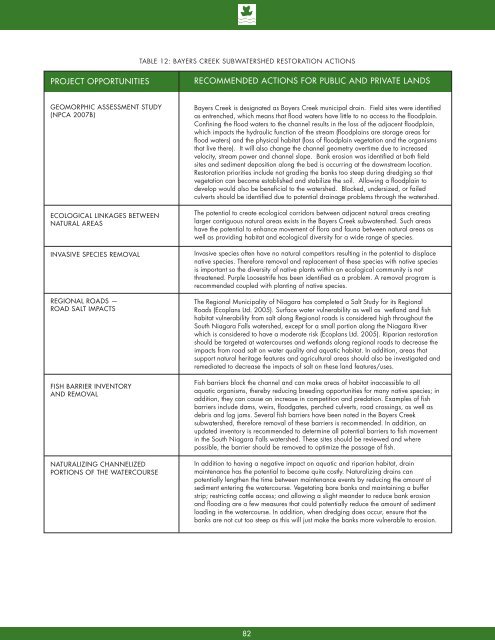8132 - NPCA SNF Watershed Report.indd - Niagara Peninsula ...
8132 - NPCA SNF Watershed Report.indd - Niagara Peninsula ...
8132 - NPCA SNF Watershed Report.indd - Niagara Peninsula ...
You also want an ePaper? Increase the reach of your titles
YUMPU automatically turns print PDFs into web optimized ePapers that Google loves.
Table 12: Bayers Creek Subwatershed Restoration ActionsPROJECT OPPORTUNITIESRECOMMENDED ACTIONS FOR PUBLIC AND PRIVATE LANDSGEOMORPHIC ASSESSMENT STUDY(<strong>NPCA</strong> 2007B)ECOLOGICAL LINKAGES BETWEENNATURAL AREASINVASIVE SPECIES REMOVALREGIONAL ROADS —ROAD SALT IMPACTSFISH BARRIER INVENTORYAND REMOVALNATURALIZING CHANNELIZEDPORTIONS OF THE WATERCOURSEBayers Creek is designated as Boyers Creek municipal drain. Field sites were identifiedas entrenched, which means that flood waters have little to no access to the floodplain.Confining the flood waters to the channel results in the loss of the adjacent floodplain,which impacts the hydraulic function of the stream (floodplains are storage areas forflood waters) and the physical habitat (loss of floodplain vegetation and the organismsthat live there). It will also change the channel geometry overtime due to increasedvelocity, stream power and channel slope. Bank erosion was identified at both fieldsites and sediment deposition along the bed is occurring at the downstream location.Restoration priorities include not grading the banks too steep during dredging so thatvegetation can become established and stabilize the soil. Allowing a floodplain todevelop would also be beneficial to the watershed. Blocked, undersized, or failedculverts should be identified due to potential drainage problems through the watershed.The potential to create ecological corridors between adjacent natural areas creatinglarger contiguous natural areas exists in the Bayers Creek subwatershed. Such areashave the potential to enhance movement of flora and fauna between natural areas aswell as providing habitat and ecological diversity for a wide range of species.Invasive species often have no natural competitors resulting in the potential to displacenative species. Therefore removal and replacement of these species with native speciesis important so the diversity of native plants within an ecological community is notthreatened. Purple Loosestrife has been identified as a problem. A removal program isrecommended coupled with planting of native species.The Regional Municipality of <strong>Niagara</strong> has completed a Salt Study for its RegionalRoads (Ecoplans Ltd. 2005). Surface water vulnerability as well as wetland and fishhabitat vulnerability from salt along Regional roads is considered high throughout theSouth <strong>Niagara</strong> Falls watershed, except for a small portion along the <strong>Niagara</strong> Riverwhich is considered to have a moderate risk (Ecoplans Ltd. 2005). Riparian restorationshould be targeted at watercourses and wetlands along regional roads to decrease theimpacts from road salt on water quality and aquatic habitat. In addition, areas thatsupport natural heritage features and agricultural areas should also be investigated andremediated to decrease the impacts of salt on these land features/uses.Fish barriers block the channel and can make areas of habitat inaccessible to allaquatic organisms, thereby reducing breeding opportunities for many native species; inaddition, they can cause an increase in competition and predation. Examples of fishbarriers include dams, weirs, floodgates, perched culverts, road crossings, as well asdebris and log jams. Several fish barriers have been noted in the Bayers Creeksubwatershed, therefore removal of these barriers is recommended. In addition, anupdated inventory is recommended to determine all potential barriers to fish movementin the South <strong>Niagara</strong> Falls watershed. These sites should be reviewed and wherepossible, the barrier should be removed to optimize the passage of fish.In addition to having a negative impact on aquatic and riparian habitat, drainmaintenance has the potential to become quite costly. Naturalizing drains canpotentially lengthen the time between maintenance events by reducing the amount ofsediment entering the watercourse. Vegetating bare banks and maintaining a bufferstrip; restricting cattle access; and allowing a slight meander to reduce bank erosionand flooding are a few measures that could potentially reduce the amount of sedimentloading in the watercourse. In addition, when dredging does occur, ensure that thebanks are not cut too steep as this will just make the banks more vulnerable to erosion.82
















